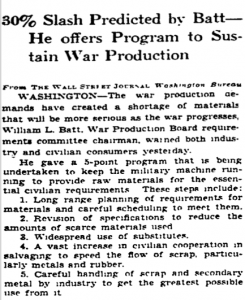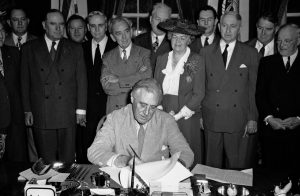“30% Slash Predicted by Batt – He offers Program to Sustain War Production”, The Wall Street Journal, June 4, 1942

This excerpt is from a Wall Street Journal article published on June 4, 1942, outlines the War Production Board committee chairman William L. Blatt’s five-point program that would prevent a shortage of raw materials for civilian production of military munitions and vehicles. His five points include long range planning, revising the extent to which scarce materials were used, expansion of substitutes, increasing civilian salvaging of scrap metal and rubber, and utilizing the scrap to reuse as much material as possible. Released only a few short months after the United States entered World War One, the plan aims to continue civilian manufacturing of military goods. In a period where the country experienced full employment, the need for increased labor to meet wartime needs allowed previously unwelcomed groups, such as African Americans and women, into the workplace. This resulted in greater participation for minority groups in industry following the conclusion of the war. The committee was created by FDR to address production of wartime munitions, artillery, and vehicles, and forcing factories to comply with its orders fell in line with the President’s pro-government intervention narrative introduced following the Great Depression.
President Roosevelt Signs the G.I. Bill (June 22, 1944)

In this photograph, President Roosevelt signs the Servicemen’s Readjustment Act of 1944, commonly known as the “G.I. Bill.” The President is surrounded by veterans, families of veterans, and lawmakers in a signing ceremony that took place in the Oval Office on June 22, 1944. Introduced with a focus on helping veterans following the end of World War Two, the G.I. Bill provided low-interest mortgages to combat veterans, as well as tuition assistance and living stipends. An inordinate number of individuals signed up for this program, with veterans comprising over forty-nine percent of college admissions in 1947. With a better educated workforce arising right around 1950, the United States saw an enormous increase in its middle class and helped the nation surpass its pre-Great Depression levels of production and income, an economic boom that continued into the late 1950s and early 1960s.
